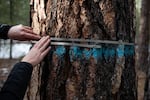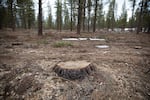
Jamie Dawson with the conservation group Oregon Wild measures a ponderosa pine marked for cutting west of Bend, Ore., Tuesday, March 8, 2022. The group has urged the U.S. Forest Service to spare large, old trees marked for cutting.
Bradley W. Parks / OPB
Just steps off the popular Pine Drops mountain bike trail west of Bend, some of the larger, older pines in the surrounding forest could soon be dropping.
Blue rings of paint mark the puzzle-piece bark of the trees slated for removal in a timber sale that’s part of the years-old West Bend Project, a forest restoration effort that aims to guard the city from catastrophic wildfire through selective logging, mowing and prescribed burning on 26,000 acres of adjacent national forestland.
The sale has stoked the flames of a long-running debate in Oregon: Which trees are too big to cut? Two key stakeholders in the project — the U.S. Forest Service and the conservation group Oregon Wild — are at odds over the answer.
Oregon Wild is raising concerns that several of the trees marked for removal are old growth ponderosa pine, a rarity in the project area, and that cutting them down violates guidelines laid out when the project began in 2010.
“The project is actually logging some of the most fire-resistant trees and calling it fire risk reduction,” said Erik Fernandez, Oregon Wild’s wilderness program coordinator. “There’s just no logic to that.”
The Forest Service, on the other hand, says that while a small number of trees are pretty old and pretty large, none of them are old growth and all of them are eligible for thinning.
“These trees aren’t inappropriately marked,” said Jean Nelson-Dean, public affairs officer for the Deschutes National Forest. “They are not old growth. They are not demonstrating old-growth characteristics.”

Oregon Wild's Jamie Dawson uses a special tape measure to determine a tree's diameter at breast height, a common measure of a tree's size. Her conservation group wants ponderosa pines 21 inches in diameter and larger to be off-limits from logging.
Bradley W. Parks / OPB
The sides disagree on how many of the marked trees are too big to cut and whether the timber sale meets the goals laid out when the West Bend Project began in 2010.
The project’s forestland provides vital wildlife habitat. Mountain bike trails in the renowned Phil’s Trail system weave throughout. Bend homes, schools and businesses are also close by.
Heavy logging in the early to mid-1900s and years of fire suppression in this forest created the conditions for severe wildfire. The West Bend Project was designed to make the forest more resilient to defend the growing city from encroaching blazes.
“Without those treatments, this forest on the edge of Bend is much more vulnerable to high-severity fire,” said Deschutes County Commissioner Phil Chang, who has had a hand in the project from the beginning.
Chang co-chairs the steering committee of the Deschutes Collaborative Forest Project with Bend Mayor Sally Russell. The collaborative advises the Forest Service in its management of the West Bend Project and other restoration work on the forest.
Chang said one of the collaborative’s goals for the project was to preserve the largest, oldest trees and give them room to thrive in open stands by reducing the density of mid-sized trees and undergrowth. He said that of the thousands of acres of selectively logged forest he’s reviewed across the West Bend Project, he thinks the vast majority of it aligns with that intention.
But Chang added that, in his opinion, the marked trees Oregon Wild has drawn attention to are different — not quite old growth, but definitely older than most of the trees on the landscape.
“I don’t think this mark really aligns that well with the purpose and need for the West Bend Project overall,” Chang said.
Chang, Russell and collaborative Vice Chair Ed Keith issued a statement last week saying that “if 99 percent of the acres commercially thinned are moving our forest in the right direction then we don’t think it is appropriate to vilify the Forest Service for the 10 acres which could be inconsistent with the overall intent and vision of the [Deschutes Collaborative Forest Project].”

Many trees have already been cut along the Pine Drops trail and throughout the 26,000-acre West Bend Project. After small and mid-sized trees are cut, understory vegetation is mowed and prescribed burning is conducted to create more open tree stands.
Bradley W. Parks / OPB
There is no hard-and-fast rule in the West Bend Project area dictating which trees are too big to cut.
Oregon Wild has started a petition urging the Forest Service to adopt strict size limits on which trees can be cut in all active projects. For ponderosa pines, the group says the limit should be 21 inches in diameter at breast height, a common measure of a tree’s size, and 24 inches for firs and other large species. The “21-inch rule” was previously applied across 8 million acres of Eastern Oregon for decades to safeguard bigger, older trees, but those rules changed under the Trump administration.
Oregon Wild’s Fernandez said he’s documented at least three dozen trees in the timber sale that would be off limits if those rules existed in the West Bend Project area. He said that just because leaders of the collaborative agree the rest of the forest is being treated properly, that doesn’t mean these trees aren’t worthy of protection.
The marked trees are still standing for now. The Deschutes National Forest announced Wednesday that the Pine Drops and other mountain bike trails as well as forest roads in the timber sale area were to temporarily close for timber harvesting and forest restoration work starting Thursday.
“I fear the chainsaws and bulldozers are gonna be on their way very soon,” Fernandez said.
The trees are under contract to be cut and have been marked for about two years, Chang said. Keeping the trees standing would require a renegotiation of the contract with the timber operator.
